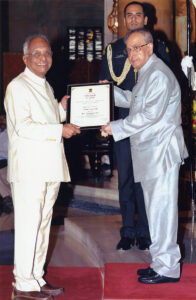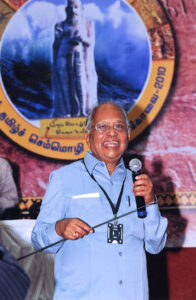Registered with the Registrar of Newspapers for India under R.N.I 53640/91
Vol. XXXI No. 2, May 1-15, 2021
In Memoriam: Dr. R. Krishnamurthy – Journalist-turned-Numismatist
by Suresh Sethuraman*

RK receiving Tholkappiar Award from Dr. Pranab Mukherjee.
Dr. R. Krishnamurthy – RK to his friends and admirers in India and abroad – Editor of the popular Tamil daily Dinamalar, passed away on March 4, 2021, at his residence at Besant Nagar. He was 88. Not many are aware that apart from being a journalist he was also an archaeologist, epigraphist and numismatist.
RK was born on January 13, 1933, at Vadiveeswaram near Nagercoil that was then a part of the kingdom of Travancore. His father T.V. Ramasubba Iyer owned agricultural lands and saltpans in the area. Iyer was also a social worker who later founded the newspaper Dinamalar at Tiruvananthapuram.
RK had his early education at the Sethulakshmibai English High School at Nagercoil and later, the Scott Christian College in the same town. Subsequently, he obtained his B.Sc. degree in Geology, with a First Class, as a student of the Alagappa College (now University), Karaikudi. He obtained his master’s degree in the same subject, with a First Class-First Rank, from the Presidency College, Madras, in 1956. He wanted to pursue higher education in the United States but his father instructed him to join the family businesses.

RK speaking at World Tamil Conference, Coimbatore, 2010.
In 1956, RK joined the Dinamalar and shifted its main office from Tiruvananthapuram to Tirunelveli. Soon, he was also in-charge of the newspaper’s new edition brought out from Tiruchirappalli. In 1977, RK became the Editor of the newspaper and began to work full-time from Chennai.
RK was elected the General Secretary of the All India Newspaper Editors’ Conference in 1991. He occupied this post till 1996. As a member of the Print Media Group that accompanies the President and Prime Minster of India on official visits abroad, RK visited several countries such as Malaysia (1977, 1987), China (1988, 2001), U.S.A. (2002, 2005), Pakistan (2004), Iceland and Switzerland (2005) and Myanmar (formerly Burma) and Mauritius (2006).
After having established Dinamalar as a leading newspaper in this part of the country, RK began to seriously pursue his interests in art, archaeology and numismatics. His interest in Tamil language, grammar and literature gradually led him to the study of the ancient scripts, inscriptions and coins of southern India.
Around the year 1976, resisting opposition from several traditional Tamil scholars, RK boldly introduced a reformed or simplified form of the Tamil script in his newspaper Dinamalar. This avoided the use of cumbersome loops for certain letters. It eventually came to be called the ‘Periyar Script’ as it was first advocated by Periyar E.V. Ramasamy, the great social reformer and leader. In due course, several other Tamil newspapers and magazines adopted it. In 1979, the Government of Tamil Nadu adopted it for use in some of the school textbooks.
RK’s interest in Tamil script led him to research the origin of the Tamil language. Thus, he studied Vattezhuthu in which the Tamil language was written a few centuries ago. He authored three major books on his findings. Subsequently, he studied Tamil Brahmi script – in which Tamil was written around two thousand years ago.
RK discovered, studied and published several coins minted by the Chera, Chola and Pandya kingdoms of the Sangam Age (around 300 B.C to 300 A.D.). Some of these displayed interesting legends or inscriptions in the Tamil language and Tamil Brahmi script. For example, a coin of the Pandya kingdom bore the legend Peruvazhuthi, the surname or last name of several Pandya kings. Similarly, a coin of the Chera kingdom exhibited the legend Makkotai, the name of a Chera king. RK also discovered and studied the coins of the Malaiyaman chiefdom of the Sangam Age. These Malaiyaman kings ruled from Tirukoilur or Kovalur in northern Tamil Nadu as their capital. His researches on the coins of the Sangam Age kings led to several monographs and catalogues in Tamil and a comprehensive book titled Sangam Age Tamil Coins in English. The latter book was first published in 1997 and a second edition was released in 2003. This is the sole publication on this subject in English and is rightly regarded as his magnum opus. Prior to these publications by RK, historians and archaeologists were totally unaware that these Sangam Age kingdoms had a flourishing coin-based economy and trade.
RK had an enviable personal collection of old coins including coins of the famed Pallava dynasty that ruled from around 300 A.D. to 800 A.D., with Kanchipuram or Kanchi in northern Tamil Nadu as the capital. Based on the Pallava coins in his collection and those in the museums in London, Colombo and New Delhi, RK authored the book The Pallava Coins in 2004. Profusely illustrated, this volume is again the only comprehensive publication in English on this subject.
Besides studying the coins of the various local dynasties, RK studied and published monographs on the ancient Greek and Roman coins found in Tamil Nadu, mainly in and around the historic town of Karur. He also studied and published certain interesting and rare Chinese coins discovered in Tamil Nadu. These had obviously reached Tamil Nadu during the course of trade centuries ago and impacted the local economy and art. Indeed, some of the Sangam Age Tamil kings produced coins modeled on the Roman coins.
RK was closely associated with the Numismatic Society of India, headquartered in Varanasi, India’s oldest academic organisation devoted to the study of the coins. Many of RK’s research findings on ancient coins have appeared in the Society’s journal.
With a view to promote and encourage research on the coins of southern India, mainly Tamil Nadu, RK established the Tamil Nadu Numismatic Society in Chennai in 1986. Around 1991, he, along with a few other senior scholars, founded the South Indian Numismatic Society. It has now emerged as a major academic organisation in our part of the country and is particularly known for its journal Studies in South Indian Coins, published annually. Several of RK’s research papers have been published in this journal.
RK’s path-breaking studies and discoveries earned him several coveted awards and honours in India and abroad. On invitation, he delivered lectures and presented his research findings at several international conferences, mainly in Europe. In 1996, he presided over the Annual Conference of the Numismatic Society of India held at Pune in Maharashtra. The same Society also awarded him the C.H. Biddulph and T. Desakachari medals. In 1998, he was elected as a Fellow of the Royal Numismatic Society in London. A year later, he presided over the Annual Conference of the South Indian Numismatic Society held at Kanyakumari. In 2004, the Madurai Kamaraj University, Madurai conferred on him the degree of Doctor of Science (Honoris Causa). In 2015, RK received the prestigious Tholkappiar Award from Dr. Pranab Mukherjee, the then President of India.
As a journalist and a scholar, RK had a personal library of over 5,000 books and periodicals in English and Tamil. Most of these publications were on Tamil language and literature, History, Archaeology, Numismatics, Paleography and Epigraphy.
Not many are aware that RK was a philanthropist who supported genuine academic research and heritage-related activities. He has funded several academic conferences, workshops and publications, mainly related to numismatics. He instituted a medal, named after P.L. Gupta, the renowned numismatics scholar, to be awarded by the South Indian Numismatic Society to distinguished scholars working in the field of numismatics. Whenever foreign scholars visited Tamil Nadu, he arranged to receive them at the Chennai International Airport and made all arrangements for their stay and visits to archaeological sites and museums all over Tamil Nadu, all at his cost.
RK was an admirer and supporter of the Indian National Trust for Art and Cultural Heritage (INTACH), Asia’s largest voluntary organisation for the promotion of art and culture. In March 2000, he partially sponsored a unique workshop on Indian Numismatics organised by INTACH at Chennai. It was primarily meant for school and college teachers and coin-collectors and renowned scholars like B.N. Mukherjee of the University of Calcutta and B.D. Chattopadhyaya of Jawaharlal Nehru University, New Delhi were among the faculty. Later, from 2013 to 2015, RK sponsored several Heritage Awareness and Documentation Programs of INTACH’s Tamil Nadu State Chapter at Kanchipuram, Madurai, Nagercoil and Kanyakumari.
* Dr. S.Suresh, Consultant – Archaeological Tourism and Museum Management, Tamil Nadu State Convener – INTACH, Chennai.

